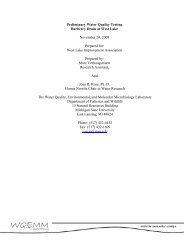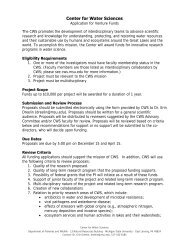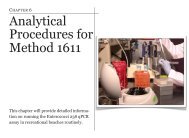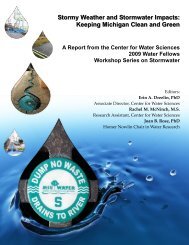Chapter 3 Setting up a qPCR Laboratory
Chapter 3 Setting up a qPCR Laboratory
Chapter 3 Setting up a qPCR Laboratory
You also want an ePaper? Increase the reach of your titles
YUMPU automatically turns print PDFs into web optimized ePapers that Google loves.
CHAPTER 3<strong>Setting</strong> <strong>up</strong> a<strong>qPCR</strong>laboratoryOnce the feasibility studies are completedand the decision has been made to switch to<strong>qPCR</strong>, a fully equipped laboratory has to beset <strong>up</strong>. One advantage of setting <strong>up</strong> a <strong>qPCR</strong>laboratory is that it can be used for additionalanalytical testing including sourcetracking or other public health related medicaltesting. In this chapter, we will focus onthe details for setting <strong>up</strong> a laboratory that iscapable of conducting <strong>qPCR</strong> assays.
Design for a <strong>qPCR</strong> <strong>Laboratory</strong>CONTENTS3.1. Facility Design3.2. Instrument Selection, Calibration andStandardization3.3. <strong>Laboratory</strong> Quality Assurance and QualityControl3.4. Personnel Training3.1. Facility DesignThe laboratory workflow should be designed to prevent contaminationof current <strong>qPCR</strong> reactions with products from previousassays, cross-contamination between samples, and contaminationfrom other analytical testing; all are potentialsources of invalid <strong>qPCR</strong> results. Therefore, it is recommendedthat there should be strict separation between workstationsand/or different steps of the <strong>qPCR</strong> method. Thus, a laboratoryperforming <strong>qPCR</strong> analyses on environmental samples shouldbe divided into several physically separate workstations.Some of these stations should be physically separatedwhereas others can be combined in a singleroom depending on the physical space.Examples for workstation designations are as follows:•Membrane filtration workstation•Nucleic acid extraction workstation (This station can be combinedwith the membrane filtration station)•Mastermix preparation workstation (ideally using positivepressure to prevent the introduction of contamination). Thisstation has to be strictly separated from other workstationsand preferably should be set <strong>up</strong> in a separateroom.20
•Reaction preparation workstation (ideally using negativepressure to keep template nucleic acids in the station). Thisstation can be on a clean bench top if there is limited spaceclose to the amplification and product detection workstation.Figure 3.1. Diagram of workflow.• Amplification and product detection workstation (This workstationhas the thermocycler).3.1.1. Designation of workstationsSeparate workstations for each step in the <strong>qPCR</strong> analysisshould be designated in order to reduce cross-contaminationand to create an efficient workflow (Figure 3.1). All stationsshould be clearly labeled and have necessary warnings onthem. Micropipettors should be dedicated to a particular stationand labeled appropriately. If your micropipettors are autoclavable,you should routinely sterilize them. If the micropipettorsare not autoclavable, wipe them down with a freshly prepared10% bleach solution and UV sterilize for 20 minutes.All materials, s<strong>up</strong>plies, or equipment belonging to one specificworkstation should remain at their respective area at alltimes.All materials, s<strong>up</strong>plies, or equipment belonging toone specific workstation should remain in its respectivearea.Membrane Filtration WorkstationThis workstation should be designed for the preparation andstorage of the filters obtained by filtering the environmentalwater samples. Fresh gloves and dedicated laboratory coatsshould be worn at all times to control contamination. Personnelshould perform tasks at this workstation before working inthe crude DNA extraction, mastermix preparation, reactionpreparation or amplification and product detection workstati21
Crude DNA extraction workstation should be designed forcrude DNA extraction from the prepared filters and preparationof calibrators and controls. This station can be combinedwith the membrane filtration station. Fresh gloves should beworn at all times to control contamination. Personnel shouldperform tasks at this workstation before working in the mastermix preparation, reaction preparation or amplification andproduct detection workstations and should not move fromthese workstations back to the crude DNA extraction workstation.ons to avoid contamination. Samples, equipment or s<strong>up</strong>pliesshould not move from these workstations back to the membranefiltration workstation.Mastermix Preparation WorkstationCrude DNA extraction workstationExtra care needs to be taken to avoid reagent contaminationin this workstation. Ideally, this station should be in a separateroom, if physical space allows. If this can not be met, adedicated bench top with a PCR hood is required.22
The mastermix preparation workstation should be designatedONLY for the preparation and storage of <strong>qPCR</strong> reagents (mastermixes, primers and probes, water, bovine serum albumin).Figure 3.2. Example label for the Mastermix Preparation Workstation.Addition of master mixes to PCR tubes or 96 well platesshould be performed at this workstation.Materials from other workstations should not bebrought to the mastermix preparation workstation.To prevent cross-contamination and to avoid repeated freezingand thawing, reagent-stock solutions should be aliquotedinto smaller “working” volumes and stored in a dedicated refrigeratora this workstation for later use. It is recommendedthat the workstation be under positive pressure.All workstations should have labels describing the the worksflowin the workstation and decontamination procedures.The mastermix preparation workstation should have dedicatedadjustable pipettes (preferably autoclavable) withplugged, aerosol-barrier or positive-displacement pipette tips,laboratory coats, and disposable gloves. Fresh gloves and dedicatedlaboratory coats should be worn at all times to controlcontamination and should not be worn in other sections of thelaboratory. Personnel should perform tasks at this workstationbefore working at the membrane filtration, crude DNA extraction,reaction preparation or amplification and product detectionworkstations and should not move from these workstationsback to the mastermix preparation workstation.23
Reaction Preparation WorkstationThe reaction preparation workstation should be designatedfor adding sample DNA extracts, positive and negative controlsand calibrators to the mastermix. The processed samplesand controls should be added to tubes containing PCRmaster mix in this workstation.Whenever possible, PCR tubes should be capped as soon asthe sample is added. When using PCR plates and adhesive covers,positive controls and calibrators should be separated fromwells with field samples to avoid contamination during templateaddition. This workstation should have dedicated adjustablepipettes with plugged, aerosol-barrier tips or positivedisplacementtips. Fresh gloves and laboratory coats shouldbe worn at all times to control contamination from this workstationto any other location. This workstation should ideallybe kept under negative pressure to prevent contamination outsideof the workstation.Nothing from this workstation should be takenback into the reagent preparation workstation.Ideally, two biological safety cabinets should be used withinthe workstation—one for sample and negative control preparation,and the other for positive control preparation—to protectthe samples from cross-contamination and to protect workersfrom exposure to pathogens. Separate pipettes and laboratorycoats also should be designated for work in each hood.Amplification and Product Detection WorkstationThis workstation should be designated for activities associatedwith <strong>qPCR</strong> amplification. The thermocycler should be locatedat this workstation. Gloves and laboratory coats should beworn at all times and removed before leaving the workstationto control amplicon contamination of other locations. Allequipment should be dedicated to this workstation.All workstations should be labeled with instructions for operating.In addition to these workstations, laboratories may want24
3.2. Instrument Selection, Calibrationand StandardizationThere are many different models of <strong>qPCR</strong> instruments availableon the market. Depending on the user’s needs, severaltypes of blocks are available which accept a variety of PCR reactionvessels (48-well plates, 96-well plates, 384-well plates,384-microwell cards or 3072-through-hole plates).Although there are several options, all <strong>qPCR</strong> instruments needto provide:• An excitation source, which excites the fluorescent dyes,to include a designated enclosed area or workstation for samplereceiving and storage. This workstation would contain refrigeratorsfor sample storage and should be isolated from anyof the other areas. Personnel should not move from this workstationto the mastermix preparation workstation. A list of<strong>qPCR</strong> equipment and s<strong>up</strong>plies organized by station is providedin <strong>Chapter</strong> 4.In the absence of a laminar flow hood or biologicalsafety cabinet, protective dust masks or surgicalmasks may be worn to further reduce the risk ofcontamination of airborne nucleic acids from theanalyst.• A detector to detect the fluorescent emissions (specificallyFAM),• And software for data collection and analysis.The equipment used to perform <strong>qPCR</strong> methods should functionproperly and generate reliable data. To verify that equipmentis functioning properly, the laboratory should have aschedule for equipment maintenance. The schedule should includethe set<strong>up</strong>, calibration, repair, record keeping, and normaloperation of all equipment used in sample analysis, asstated in the SOP for each individual instrument or method.The results of all tests should be documented in an equipmentlogbook and/or electronic database. The logbook or databaseshould be checked monthly by the QA/QC officer or the labora-25
tory s<strong>up</strong>ervisor, and any problems and corrective actionsnoted.As previously stated, equipment should be dedicated to a specificlaboratory workstation, and the instrument manualsfrom the manufacturer should be available.Individual laboratories should decide which tests to performto assess the functionality of the instruments and the frequencyof calibration. Examples of PCR quality assurancemeasures are provided in the 2004 USEPA guidance document,“Quality Assurance/Quality Control Guidance for LaboratoriesPerforming PCR Analyses on Environmental Samples”Sections 2.4.1 through 2.4.11.Calibration and Standardization of Instruments• Check temperatures in incubators twice daily with a minimumof 4 hours between each reading to ensure operationwithin stated limits.• Check thermometers at least annually against a “National Instituteof Standards and Technology (NIST)” certified thermometeror one that meets the requirements of NIST MonographSP 250-23. Check columns for breaks.• The spectrophotometer should be calibrated each day of useusing OD calibration standards. Follow manufacturer instructionsfor calibration.• Micropipettors should be calibrated at least annually andtested for accuracy on a weekly basis.• Follow manufacturer’s instructions for all calibrations. It isrecommended that thermocyclers be re-calibrated every 1-3years.3.3. <strong>Laboratory</strong> Quality Assurance andQuality ControlThe successful application of <strong>qPCR</strong> requires proper use of techniquesand interpretation of results. This method can amplifysmall amounts of nucleic acid and therefore, it is essential toestablish standardized quality assurance and quality controlprocedures.QA/QC procedures are necessary because the ability of <strong>qPCR</strong>to produce many copies of target DNA creates the possibilityof contamination by previously amplified products, which canlead to false-positive results. A good QC program will also detectfalse negatives resulting from inhibition or underestimationof the target.Laboratories performing <strong>qPCR</strong> analyses on environmentalsamples should develop a written QA Management Plan thatdescribes how the laboratory will conduct its day-to-day routineoperations in order to ensure accurate result reporting.26
The main components of a QA Management Plan include:plans for personnel training, facility design, sampling forms,list of equipment, list of reagents and kits, handling and storageof reagents and kits, sample collection and processing protocols,method sensitivity, precision and recovery records,documentation of controls, data reporting and plans for correctiveaction measures. The plan should further include proceduresfor proficiency testing, data recording, data evaluationand the limitations of test results.Quality control should include descriptions and proceduresfor positive and negative controls (method blank, filter blank,no template control, calibrator, salmon processing control),the development of calibration curves and the frequency theyneed to be performed. Inhibition must also be defined withinthe context of the method. For example, the US EPA definesinhibition a 3 cycle threshold difference between thecalibrator-SPC pair and unknown-SPC pair. Also, acceptablelevels of detection limits within the negative control (notemplatecontrol, NTC) must be determined:• >35 CT in more than a single NTC•







